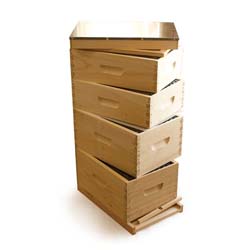Synthetic pesticides
Some of the popular miticides available in the US are marketed as Apivar, Apistan (strips), Check-Mite (strips), and Hivastan (patties). Many commercial beekeepers use these to keep Varroa at bay, but they are also popular with hobbyist beekeepers. Because they are generally applied by opening the bee box and simply setting or sliding the treatment into place, it is an effective but less time-consuming treatment.
Organic Acids
These are organic compounds that are used with equipment to fumigate the colony when no brood is present. They can also be applied using methods of spraying (from a spray bottle) and trickling. It’s recommended to use personal protective equipment (PPE) such as a face and eye mask and gloves whenever one is handling the acid. The most common are oxalic acid and formic acid.
Essential Oils
Thymol (thyme oil) and other botanical oils such as wintergreen, peppermint, tea tree and eucalyptus have been proven to repel Varroa. Thymol can be found as patties or squares in Apiguard, Apilife, and Thymovar. They are easy to apply by setting an application inside the hive on top of the frames.
While thymol helps repel mites, its strong scent can overwhelm bees’ sensitive sense of smell and may drive them away if not applied properly. Some beekeepers use inventive applications such as dabbing essential oils on the corners and edges of the brood supers.
Management/Husbandry Options
Finally, especially for those who want to avoid using synthetic products, there are several husbandry options that involve breaking the Varroa mite breeding cycle. These are drone brood removal, queen caging, and colony splitting.
The Bottom Line
All of these treatments have been tested and proven to lower Varroa mite numbers. Remember, that timing and temperature play a key role in application of any of these methods. It’s recommended to rotate the types of treatment throughout the year. Do your homework. And choose the option/options that not only work with the season but work with your style of beekeeping.
